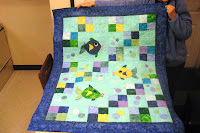If you're wondering what the "fishies quilt" tie-in is going to be, keep reading...
Tonight, the third episode of the second season of “Who Do You Think You Are”, featuring Rosie O’Donnell, aired on NBC in its usual prime time slot. You no doubt saw the promo for the episode if and when you logged in to www.ancestry.com during the past week. Ancestry got its requisite two promotional spots during first half of the show, as expected. Numbers for this episode aren’t out yet, but estimates for the first episode of this season suggest that more than 7 million people watched the Vanessa Williams story.
Last week, the Rootstech conference in Salt Lake City came to a close and 3,000 plus enthusiastic participants returned home to ponder the future of genealogy in the 21st century. No question, Rootstech was a major achievement for the organizers; they created the necessary buzz in the genealogical community and it was, hands down, probably the largest genealogical conference ever held in North America. Congrats to all involved.
Hooray for our side! We’re making inroads and apparently convincing more and more people that genealogy is fun and worthwhile.
However, for those of us who live, breathe and sleep genealogy and family history, it’s also good to maintain a sense of perspective, if only to realize that there’s still a whole lot of promotional work to be done.
For the sake of argument, let’s look at another popular hobby – one that also has conferences where (1.) attendees – not their employers - pay their own freight, (2.) offers classes and (3.) has exhibits and vendors.
Quilting shares a similar “demographic” with genealogy, skewing toward the over-40 age group, has club-like "guilds" and societies, and also has statewide, regional and national conferences. Quilters are a dedicated lot, and will travel widely to get the stuff they need. The conferences have instructional and informational classes, exhibits and vendors. (While there have been a few quilting “how-to” shows on PBS stations and cable, I don’t recall any prime time TV shows quite like “WDYTYA”.)
So, let’s compare conferences.
In 2008, more than 11,000 devotees attended the Minnesota Quilters Annual Show and Conference. Last year, more than 22,000 people attended the American Quilter’s Society (AQS) Quilt Show in Knoxville, Tennessee. Another 15,000 folks showed up in Lancaster, PA for the AQS's newest international Show and Contest. For quilting events, these are not out-of-the-ordinary numbers.
These days, a major national genealogy conference pats itself on the back if it attracts more than 1500 paid attendees. 3000 attendees can create a cataclysmic event. The idea that 11,000 people would assemble in one location in the United States to “conference” on things genealogical is still a fond wish, not a reality.
Then, consider retail therapy. A Google search for “quilt shop” generates more than 800,000 hits. A review of the hits shows a huge number of walk-in retail shops all over the US, not even counting those large nationwide fabric chains. Now, search for “genealogy bookstore”. Looking over the slightly more than 26,000 hits strongly suggests that the vast majority of those “genealogy bookstores” exist in cyberspace.
In the past half century, only a handful of “bricks and mortar” bookstores specializing in genealogy have been able to stay in business more than a decade. We closed our Pittsfield store – with more than 12,000 genealogy and local history titles - after seven years, once it became painfully obvious that retail sales wouldn’t pay for the monthly electric bill, never mind make a profit or pay the rent.
And, should you want to remind me of the famous Goodspeed’s of Boston and Tuttle’s of Rutland, I will remind you that both stayed in business and were able to sell books to genealogists not because of their genealogy departments, but in spite of them. Goodspeed’s did very well indeed selling rare Americana, autographs and prints at high prices to specialist collectors and Tuttle’s focused on publishing books on Japan in particular and Asia in general, not on genealogy. Its offices are now in North Clarendon, Vermont. And Tokyo. And Singapore. And Jakarta. Tuttle’s sold its complete stock of genealogy some years ago.
Then there are the quilting magazines, which far surpass the genealogical periodicals both in number of publications and the circulation of each. If you're a dedicated subscriber, you could easily be buried under mountains of glossy paper every month. For example, Fons and Porter’s “Love of Quilting” magazine has a circulation of 320,000. In its pre- Internet heyday, the now-defunct “Genealogical Helper” claimed a circulation of 45,000 dedicated genealogists – a wildly impressive number then as now, but a number that wouldn’t be viewed as even slightly successful in quilting circles.
In a word or two, we may want to look at how folks in the quilting field manage to generate such large conference numbers and support so many periodicals and retail outlets. We might actually learn something.
Let’s hope that “Who Do You Think You Are” converts a whole bunch of newbies to genealogy. Let’s hope we’re on the cusp of a huge surge in interest.
Perhaps there’s a bellwether we should watch.
Ancestry,com. Inc. (ACOM-Nasdaq) will announce its fourth quarter financial and full year 2010 earnings on February 24th. If Ancestry’s making money, selling more subscriptions, etc., then we can probably all assume that some of those “WDYTYA” viewers are signing on to genealogy.
In the end, that’ll be good for all of us.

No comments:
Post a Comment